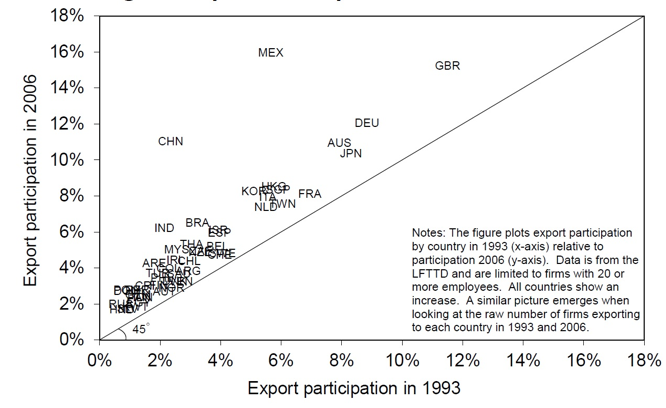Decomposing export participation Since declining entry costs, perhaps the most natural explanation for increased foreign market entry, do not explain the dramatic increase in exporting, what does? To answer this question, we combine elements of the workhorse gravity model in international trade with the Oaxaca–Blinder decomposition. This decomposition method has been widely used to study topics such as the reasons for the rise in US female labour force participation and the decline in US union membership over time. This approach helps us overcome a set of challenges to identification in our estimations. In particular, the decomposition ensures that developments within the sample outside of the first year do not affect our econometric results.
We find that improvements in telecommunications, free trade agreements, and foreign economic growth, in that order, were the primary drivers of these trends for US firms. Broader changes in tariffs, changes in the real exchange rate, and geopolitical events like the fall of the Soviet Union all played small roles. In looking at these changes across different types of firms, we generally find a similar ranking of effects. One notable result here is that for smaller firms free trade agreements played a more important role, while for larger firms changes in foreign market size were more important. We also come to similar conclusions when treating the normalization of trade relations with China in 2001 as a free trade agreement.
ConclusionWhile much has been written on the consequences of globalisation, our understanding of why these trends are occurring is only just starting to take shape. A better understanding of the causes of globalisation could help to mitigate the costs of these trends while unlocking their benefits. It could also help in understanding how globalisation might continue. Our work focuses on the experience of the US, but this may be different than that of other countries. The free trade agreements that the US signed during this period, for example, are certainly specific to its own experience. Yet both worldwide industry level export data and firm level data from Chile, Colombia, Costa Rica, India, Mexico, and Morocco suggest that these trends are not exclusive to the US. Further analyses of the experiences of other countries would help greatly in our understanding of the globalisation of firms, one of the most important developments of our time.
Authors' note: Any opinions and conclusions expressed herein are those of the authors and do not necessarily represent the views of the U.S. Census Bureau, the Board of Governors of the Federal Reserve System, or any other person associated with the Federal Reserve System. All results have been reviewed to ensure that no confidential information is disclosed.
ReferencesBaldwin, R and P Krugman (1989), “Persistent trade effects of large exchange rate shocks”, Quarterly Journal of Economics 104(4): 635–654.
Bernard, A B and J B Jensen (2004), “Why some plants export”, Review of Economics and Statistics 86(2): 561–569.
Bernard, A B and J B Jensen (2009), “Importers, exporters and multinationals: a portrait of firms in the U.S. that trade goods”, in T Dunne, J Jensen and M Roberts (eds), Producer Dynamics: New Evidence from Micro Data, University of Chicago Press, pp. 513–556.
Cairncross, F (1997), The Death of Distance: How the Communications Revolution Is Changing our Lives, Harvard Business School Press.
Friedman, T L (2005), The World Is Flat: A Brief History of the Twenty-First Century, Farrar, Straus and Giroux.
Das, S, M J Roberts and J R Tybout (2007), “Market entry costs, producer heterogeneity, and export dynamics”, Econometrica 75(3): 837–873.
Dixit, A (1989), “Entry and exit decisions under uncertainty”, Journal of Political Economy 97(3): 620–638.
Freund, C L and D Weinhold (2004), “The effect of the internet on international trade”, Journal of International Economics 62(1): 171–189.
Kehoe, T J and K J Ruhl (2013), “How important is the new goods margin in international trade?”, Journal of Political Economy 121(2): 358–392.
Lincoln, W F and A H McCallum (2018), “The rise of exporting by U.S. firms”, European Economic Review 102: 280-297.
Melitz, M J (2003), “The impact of trade on intra-industry reallocations and aggregate industry productivity”, Econometrica 71(6): 1695–1725.
Roberts, M and J R Tybout (1997), “The decision to export in Colombia: an empirical model of entry with sunk costs”, American Economic Review 87(4): 545–564.




 雷达卡
雷达卡




 提升卡
提升卡 置顶卡
置顶卡 沉默卡
沉默卡 变色卡
变色卡 抢沙发
抢沙发 千斤顶
千斤顶 显身卡
显身卡







 京公网安备 11010802022788号
京公网安备 11010802022788号







